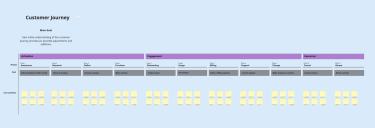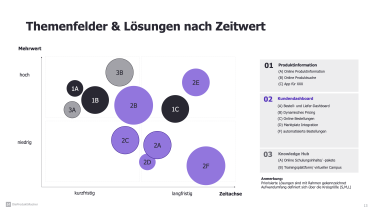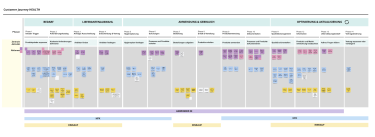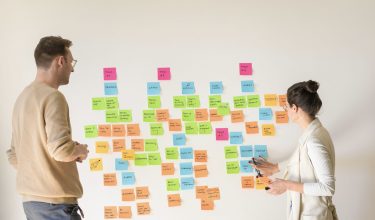
#Service Designer #service design & concept #service design

28. Jul 2022 |
- min Lesezeit
Our approach to product development is built around the customer. We look at all of your customer touchpoints from awareness through to retention. The customer journey is the most useful starting point for continued innovation and value creation. We want to ensure that your customers enjoy that journey with you, not your competitors. To achieve this, we zoom out to see your entire offer in context. The workshop is designed to solve problems. The outcome is a clear action plan that you and your team can implement together. This is achieved by discovering potential opportunities and removing barriers. With a clear overview, you’ll be able to clearly prioritize the action steps you need to take. This kind of objective analysis can be hard without the input of a third party. That’s where we come in.

Our clients normally approach us when they feel stuck in some way. Because it’s evidence based and data driven, our Customer Journey Workshop can remove the feeling of strategic paralysis that leads to indecision. Clients are often successful with their core business, but they’re at a crossroads and need to make an important decision. Sometimes it can be hard to know exactly where to turn or what actions to prioritize. This is particularly true when there are many potential solutions on the table. Which one do we choose? How can we decide which option will create the most value? Common challenges include:
There’s a strong desire to identify opportunities for growth, as well as retain existing customers.
The CJW takes a holistic view of both market trends and the customer journey to uncover new business potential.
Common challenges include:
This leads to communication problems and can make attribution a real challenge, leading to overspend.
The CJW can reveal better ways to share data and improve the efficiency of communication.
This leads to the Silo Effect which creates duplication and an inconsistent customer experience (we’re back to that first statistic again).
The CJW unifies all departments and stakeholders to make them feel involved and ensure they’re working with a single vision.
We review all the existing material you have about your customers and their interaction with the business. This material could be anything from customer personas to existing touchpoints and solutions.
We work together with the client to collate the data you have and to fill the information gaps.
For example, we sometimes find that clients don’t have enough user data from Analytics. We then support the client to gather this data and share it throughout the organization. Map Existing Knowledge We review all the existing material you have about your customers and their interaction with the business. This material could be anything from customer personas to existing touchpoints and solutions.
We work together with the client to collate the data you have and to fill the information gaps.
For example, we sometimes find that clients don’t have enough user data from Analytics. We then support the client to gather this data and share it throughout the organization.
In most customer journeys there’ll be some overlap between the different target groups and stakeholders. For example, customer service might not be used to working with marketing, but the customer sees both departments as part of the same brand.
By identifying who these different groups are, we can start to visualize how all these touchpoints relate to each other. This creates a holistic picture and leads to clarity.
We clearly mark out the journeys of the distinct target groups. We then review the current touchpoints to see how the customer’s needs are currently being fulfilled.
Maybe everything is perfect, but there are too many resources in one place? Maybe there are gaps. The touchpoint map will reveal those gaps.
When we have the map of the current customer offer, we then look at the areas for improvement. For example, the existing strengths and weaknesses might be in the sales funnel.
Do certain target groups have certain problems in common? Could they benefit from products and solutions that you already offer?

The results of the workshop vary depending on the client and their business.
Because we take a macro view of the business and its customers, we’re able to recommend a wide variety of initiatives. Opportunities for improvement can be discovered at every stage of the sales funnel.
These include:
Results typically fall into time-frames:
1. Quick Wins – We help the client to identify small gaps in the journey that are easy to close. This could be small changes to UX or sharing techniques for conversion optimization.
2. Medium Term – With increased clarity, the product vision becomes much clearer. There’s generally a better collective vision for the product within the existing marketplace.
3. Longer Term – The core benefit of a customer workshop lies in understanding the customer better and how your offer relates to the customer and the marketplace. This overview can clarify strategic direction and reveal new business opportunities.
We love to collaborate.
We consistently see that outcomes have greater impact and sustainability when the whole team is part of the conversation.
We see the client’s problem as our problem. We try to find the angle that works best for our clients, and we adapt our approach to help them meet their goals.
We’re here to facilitate growth; sometimes listening, sometimes guiding but always bringing the focus back to the customer and how we can serve them better.
We make sure that we involve all relevant disciplines in every workshop. This holistic approach encourages dialogue between the sometimes disparate areas of product, customer services and marketing.
Each member of these specialized teams can bring insight to the conversation. When a team member feels involved and listened to, they also feel valued and more motivated to implement new initiatives.
“
Great things in business are never done by one person; they're done by a team of people.
“
In the example below, we visualize a customer journey together with a client from the health industry to see how the pieces of work fit together.

The Customer Journey Workshop normally takes place over two, half-day sessions:
Day 1: Understanding and Alignment Here we look at the existing customer journeys and collate the data from different stakeholders. We identify challenges and opportunities - Involve and Include.
Day 2: Prioritizing and Creation This session is all about identifying potential and creating clear steps to achieve it - Take Action.
Workshop Features Fully tested format that works remotely or on-site Interactive break out sessions. This means people can collaborate immediately, even when working as part of a large international team
The Customer Journey Workshop is an integral part of an organization’s digital strategy. It provides a framework to identify growth potential from the customer’s perspective:
Customer expectations are evolving rapidly. The Customer Journey Workshop is all about closing the gaps between what customers expect and what you deliver.
It’s all about connection. And the connection feels good!
